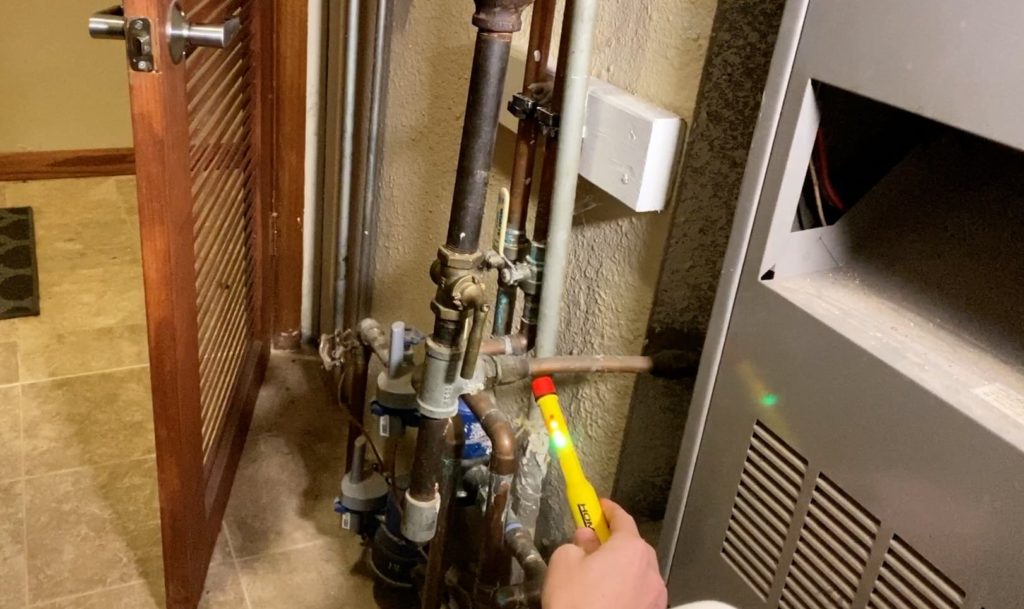Who doesn’t enjoy returning to a warm home on a cold dreary day, taking a nice warm bath, or even creating your favorite dish on a gas cooktop? Most of the appliances that make these comforts possible run on natural gas. Natural gas, butane, and propane are cost effective and readily available energy sources but also can introduce some safety concerns in your home if you’re not familiar with the signs there could be an issue.
The majority of gas leaks will be found at the connection between the flexible line coming into the back of a stove, water heater or furnace. To find a gas leak you can mix 50% dish soap and 50% water into a spray bottle. With the spray bottle set on the “stream” setting cover the treaded connection interface and look for the forming of bubbles. These bubbles indicate you have a slow leak and the connection needs to be tightened or replaced. Alternatively you can use a Gas leak detector to quickly narrow down the source of a leak.
Is There a Leak?
In the United States, Canada, and many other countries there are regulations which mandate an odorant be added to any gas which is used in residential or commercial applications. A common additive called mercaptan is added to natural gas and provides the unpleasant and easily detectable odor. So, if you smell rotten eggs or a skunk and don’t see one running around you might have a small gas leak which needs attention. Finding the source of the gas leak is often faster than people expect and the fix can be as easy as tightening a fitting to provide a proper seal. Below we will go over 2 common methods to narrow down and find the source of the leak so you can either fix it yourself or call in the pros. One thing to note is you obviously need to take care when dealing with any fluid or gas which is flammable but the regulation in the US mandates that a leak should be detectable by anyone with a “typical” sense of smell at a level which is 20% concentration to that which is needed to ignite.
Leak Detector Soapy Mix
The first method used by many plumbers and home owners is a mix of water and soap to find the source of the gas leak. The reason behind this is by applying a layer of soapy water to all connections you will be able to spot a leak since the gas coming from the pipe/fitting will blow bubbles.

The supplies needed are a spray bottle, water, and standard dish soap. Ensure the spray bottle selected has the ability to spray a stream opposed to just a mist. The stream will provide more fluid and thus a better coverage of each area. The mixture of soap to water should be a 50 / 50 mix. Since this is most likely a small project for you I would only use 1/2 cup of each to ensure you aren’t just wasting dish soap.
Note: You need to really cover the fitting with an ample amount of soapy mix. depending on the size and exact location of the leak you could think you have covered and checked a fitting but you actually missed the problem spot.
Gas Leak Detector
One method which was a little newer to me is the use of a device specifically made to detect the presence of a leak. Appropriately named a gas leak detector you can find these devices at most big box home improvement stores starting at about $25.

I used one of these detectors the other day on in the utility room of one of my rental properties and was a bit skeptical at the start with the effectiveness at detecting leaks. Since I was unsure if the detector was going to do the trick I brought some backup with a soapy water mix. The detectors need to be calibrated in an area free of any leaks and then can be used in the area of concern. If you are unsure what the heck I am talking about check out the video below which walks you through finding the leak I was searching for near a furnace gas line.
Call In The Pros
If all of this sounds a bit much and you are not confident finding the leak on your own I would recommend calling in the pros. There is a chance the leak is in a hard to reach area and the pros might need to pressure your system to track down the exact source of the leak. Start with your utility company as they will usually send a technician out at no charge to you. The utility company will usually not fix the leak but will help the detection and location of the problem. In terms of fixing the leak you can call a local plumber or if the gas line is feeding your furnace usually a HVAC company would also be able to help.




